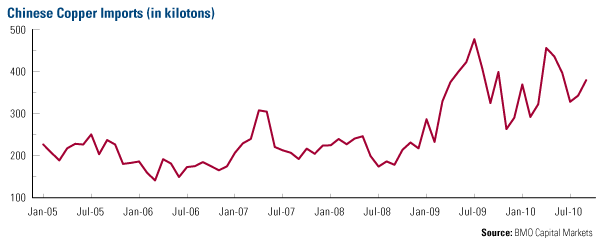LME Week is an important tradition in the global metals industry calendar that takes place each year in London during the fall. This year’s event kicked off on Monday and the spotlight on industrial metals couldn’t be brighter, especially for copper. With prices up around 13 percent so far this year, copper’s notched a spectacular rebound off its lows and currently sits about 10 percent below its all-time high set in 2008.
China’s role in the copper market rebound can’t be overstated. World consumption of copper has increased 14.9 percent from 2003-2009. But remove China from the equation and world copper consumption swings in the opposite direction to a 14 percent decline over the same time period. Meanwhile, the other BRIC countries (Brazil, India and Russia) combined have seen their copper consumption grow 15 percent since 2003.
China and emerging nations need the copper because it is the most important metal for a rapidly industrializing nation. The average single-family home uses 439 pounds of copper in construction, an air conditioner uses 52 pounds and a refrigerator uses 4.8 pounds. The average vehicle contains more than 50 pounds of copper stretching nearly a mile, and Chinese auto sales have been booming.
In order to meet its ever-increasing demand for copper supply, China has looked beyond its borders for new sources. This chart from BMO Capital Markets illustrates the rapid rate in which Chinese copper imports have risen since Beijing announced the $586 billion stimulus plan in November 2008.
BMO expects Chinese copper imports to remain robust and on the rise and says “China is commanding a significant influence over the price of copper.”
Last year’s spike in Chinese copper imports left copper in short supply for everyone else, just as demand in the developed world is beginning to turn around. Morgan Stanley (MS) reports that consumption in the U.S. is up 5 percent in 2010 versus the same time period last year, with the European Union up 12 percent and Japan up 37 percent.
MS is estimating that this rise in demand coupled with a weak supply response will have the global copper market poised to shift into a deficit this year and remain there until 2013.
This could mean we haven’t seen the end of rising copper prices. BMO just revised its 2010 price forecast up 6 percent to $3.39 a pound, as well as its forecasts for 2011 and 2012.
All opinions expressed and data provided are subject to change without notice. Some of these opinions may not be appropriate to every investor.






